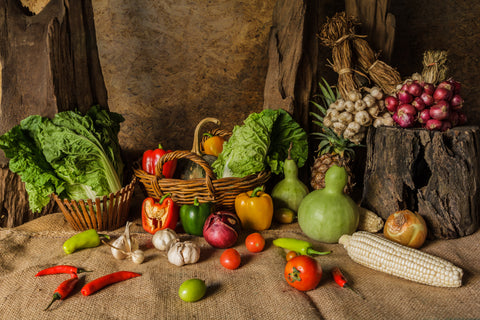Knowledge from Olle Garden Bed: How to Properly Store Fruits and Vegetable
Now that you have planted and harvested some beautiful vegetables, how will you store them? Not everyone can use the root cellar. Here are other ways to store your harvest! The following content also has some reference value for raised garden beds.

So, how do you store winter melon, beet, carrot, beet, onion, sweet potato, cabbage and other crops traditionally stored in the root cellar? Unless you plan to invest in one, here are some suggestions on how to keep the garden harvest throughout the winter.
Root cellar substitute
First, find a cool and dry place at home:
Are there any rooms in your home that are below 60 degrees (F) but above freezing?
Is there a closet on the outside wall?
Can you cut the coolest corner of the cellar or attic?
Do you have an unheated mud chamber or entrance?
How about using a picnic cooler or a clean metal dustbin with insulation in an unheated garage or shed?
My parents use their bulkheads for refrigeration. It is very convenient both indoors and outdoors, and the wide steps make the shelf very convenient. They can occasionally open the bulkhead door to increase fresh air, but the warm cellar air makes things not freeze on particularly cold nights.
How to store different vegetables
Different fruits and vegetables require different levels of temperature and humidity to store successfully. There are four basic groups:
Group 1: Cold and wet
These root crops like cold, 32 ° to 40 ° F (0 ° to 4.5 ° C), and require very wet conditions (90% humidity). They can be stored in basements or garages, but they need to be covered with packaging materials such as sand or peat moss. Then, the material should be kept moist (not damp! You can use a spray bottle as needed to increase the moisture content.
Pick root vegetables before the temperature drops below 25 ° F (- 4 ° C), brush away loose soil (do not wash them), clamp the top to 1 inch, and keep the roots intact.
Wrap beets, carrots, radishes, radishes and turnips in damp sand, peat moss or sawdust to prevent them from touching each other.
Celery keeps its best effect if it is pulled up by the root and stored upright with the root in wet sand.
Group 2: Cold and dry
Cold but drier, 32 ° to 40 ° F (0 ° to 4.5 ° C), 60% to 70% humidity.
Apples, pears, cabbage, Brussels sprouts and potatoes can be stored in the same place as root vegetables, as long as they have additional air circulation to keep them dry.
For apples and pears: Many gardeners recommend wrapping each fruit in a newspaper to help it stay longer and prevent any decay from spreading.
Cabbage and Brussels sprouts can be uprooted and replanted in a bucket or bag of damp soil.
Potatoes need to be dark and close to 40 ° F (4.5 ° C).
Keep apples in their own containers because they release ethylene gas and absorb strong flavors such as cabbage.
Bosc and Anjou pears are good keepers. Place them in a dry and ventilated place at 50 ° to 70 ° F (10 ° to 21 ° C) for one week, and then store them at 32 ° F (0 ° C).
Group 3: Cool and dry
Cool, 40 ° to 50 ° F (0 ° to 10 ° C), dry (60% humidity).
Onions, garlic and shallots are best kept in a dry, unheated spare room or closet.
Before storage, dry them in a ventilated place for about two weeks, and then weave or hang them in a mesh bag.
They can also be stored in shallow boxes or baskets no more than two layers deep.
Group 3: Cool and dry
Cool, 40 ° to 50 ° F (0 ° to 10 ° C), dry (60% humidity).
Onions, garlic and shallots are best kept in a dry, unheated spare room or closet.
Before storage, dry them in a ventilated place for about two weeks, and then weave or hang them in a mesh bag.
They can also be stored in shallow boxes or baskets no more than two layers deep.

Other storage options
Refrigerator: It is a good choice to store agricultural products that need cold, wet or cold, dry conditions in the refrigerator. Please refer to our article on keeping agricultural products fresh to learn which fruits and vegetables can be stored in the refrigerator and which can be stored elsewhere.
Stay underground: Before the ground freezes, you can store beets, carrots, radishes, potatoes, radishes and other crops directly on the garden bed. Cover them with plenty of hay or straw. They can then be dug as needed or until the ground freezes.
Extended season: Use cold frames, row covers, backyard hoops, or greenhouses to keep vegetable production going for at least a few weeks. Learn how to make a cold frame.
Making root clamps: Instead of building root cellars, dig holes in the hard ground to store cabbage, potatoes and other root vegetables. Use hay between each vegetable. Cover with thick straw and then cover with dirt to prevent any frost. Then cover it with more straw (one or two bales).
Check your storage
You can't just leave your storage and forget it. Please be sure to check your agricultural products regularly and remove anything that has begun to deteriorate! If you don't, the rot will spread to the rest. Remember the saying, "A bad apple will destroy this pile of apples.
